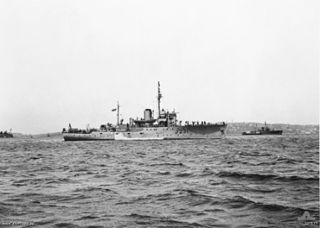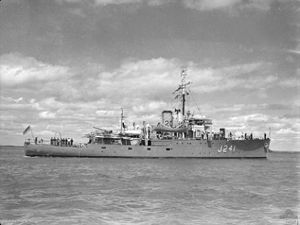
HMAS Benalla (J323/M323), named for the city of Benalla, Victoria, was one of 60 Bathurst-class corvettes constructed during World War II, and one of 36 initially manned and commissioned solely by the Royal Australian Navy (RAN). Built by HMA Naval Dockyard in Victoria, Benalla was fitted out as armed survey ship instead of a minesweeper like the rest of the class, and was commissioned into the RAN in 1943.

HMAS Deloraine (J232/M232), named for the town of Deloraine, Tasmania, was one of 60 Bathurst-class corvettes constructed during World War II, and one of 36 initially manned and commissioned solely by the Royal Australian Navy (RAN). In January 1942 she evaded an attack by the Japanese submarine I-124 north-west of Darwin and was jointly credited with the submarine's sinking after inflicting the initial damage. She was present at the bombing of Darwin and survived unscathed.

HMAS Echuca (J252/M252), named for the town of Echuca, Victoria, was one of 60 Bathurst-class corvettes constructed during World War II, and one of 36 initially manned and commissioned by the Royal Australian Navy (RAN).

HMAS Glenelg (J236/M236), named for the city of Glenelg, South Australia, was one of 60 Bathurst-class corvette constructed during World War II, and one of 36 initially manned and commissioned solely by the Royal Australian Navy (RAN).

HMAS Goulburn (J167/B243/A117), named for the city of Goulburn, New South Wales, was one of 60 Bathurst-class corvettes constructed during World War II, and one of 20 ordered by the British Admiralty but subsequently manned and commissioned solely by the Royal Australian Navy (RAN).

HMAS Inverell, named for the town of Inverell, New South Wales, was one of 60 Bathurst-class corvettes constructed during World War II, and one of 36 initially manned and commissioned solely by the Royal Australian Navy (RAN).

HMAS Junee (J362/M362), named for the town of Junee, New South Wales, was one of 60 Bathurst-class corvettes constructed during World War II, and one of 36 initially manned and commissioned solely by the Royal Australian Navy (RAN).

HMAS Katoomba (J204/M204), named after the tourist resort of Katoomba, New South Wales, was one of 60 Bathurst-class corvettes constructed during World War II, and one of 36 initially manned and commissioned solely by the Royal Australian Navy (RAN).

HMAS Latrobe (J234/M234), named for the town of Latrobe, Tasmania, was one of 60 Bathurst-class corvettes constructed during World War II, and one of 36 initially manned and commissioned solely by the Royal Australian Navy (RAN).

HMAS Mildura (J207/M207), named for the city of Mildura, Victoria, was one of 60 Bathurst-class corvettes constructed during World War II, and one of 36 initially manned and commissioned by the Royal Australian Navy (RAN). The ship was laid down by Morts Dock & Engineering Co in 1940 and commissioned into the RAN in 1941.

HMAS Stawell (J348/M348) was a Bathurst-class corvette named for the town of Stawell, Victoria. Sixty Bathurst-class corvettes were constructed during World War II, and Stawell was one of 36 initially manned and commissioned solely by the Royal Australian Navy (RAN).

HMAS Bathurst (J158), named for the city of Bathurst, New South Wales, was the lead ship of 60 Bathurst-class corvettes constructed during World War II and one of 20 built for the Admiralty but manned by personnel of and commissioned into the Royal Australian Navy (RAN). Constructed during 1940, the ship spent most of her early career operating with the British Eastern Fleet in the Indian Ocean. She returned to Australian waters in late 1944, then was deployed to New Guinea in 1945, but saw little action. Bathurst was paid off in 1946, and sold to a Sydney scrap merchant in 1948.

HMAS Wallaroo (J222), named after the town of Wallaroo, South Australia, was one of 60 Bathurst-class corvettes constructed during World War II, and one of 36 initially manned and commissioned solely by the Royal Australian Navy (RAN). Wallaroo was one of only three Bathursts lost during World War II; following a collision with US Liberty ship Henry Gilbert Costin on the night of 11 June 1943.

HMAS Parkes (J361), named for the town of Parkes, New South Wales, was one of 60 Bathurst-class corvettes constructed in Australia during World War II, and one of 36 initially manned and commissioned by the Royal Australian Navy (RAN).

HMAS Townsville (J205/M205/A124), named after the city of Townsville, Queensland, was one of 60 Bathurst-class corvettes constructed during World War II, and one of 36 initially manned and commissioned solely by the Royal Australian Navy (RAN).

HMAS Bundaberg (J231/M231), named for the city of Bundaberg, Queensland, was one of 60 Bathurst-class corvettes constructed during World War II, and one of 36 initially manned and commissioned solely by the Royal Australian Navy (RAN).

HMAS Fremantle (J246/M246), named for the port city of Fremantle, Western Australia, was one of 60 Bathurst-class corvettes constructed during World War II, and one of 36 initially manned and commissioned solely by the Royal Australian Navy (RAN).

HMAS Gawler (J188/B241/A115), named for the town of Gawler, was one of 60 Bathurst-class corvettes constructed during World War II and one of 20 built for the Admiralty but manned by personnel of and commissioned into the Royal Australian Navy (RAN). The ship was laid down by BHP at its Whyalla shipyard in early 1941, launched later that year, and commissioned in 1942.

HMAS Geraldton (J178/B242/A116), named for the city of Geraldton, Western Australia, was one of 60 Bathurst-class corvettes constructed during World War II and one of 20 built for the Admiralty but manned by personnel of and commissioned into the Royal Australian Navy (RAN).

HMAS Toowoomba (J157/B251/A125), named for the city of Toowoomba, Queensland was one of 60 Bathurst-class corvettes constructed during World War II and one of 20 built on Admiralty order but manned by personnel of and later commissioned into the Royal Australian Navy (RAN). The ship later served in the Royal Netherlands Navy (RNN) as HNLMS Boeroe.





















